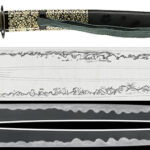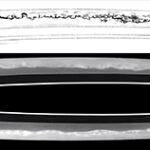Ordering number:24341
Wakizashi in Shirasaya with Koshirae (NBTHK Tokubetsu Hozon Token)
Signature: Bishu Osafune Arimitsu
Eisho 6 Nen 2 Gatsu Hi (February, 1509)
備州長船在光
永正六年二月日
Sue-koto: Jyojyo Saku, Bizen
We divide 4 sections for each sword as Saijyo Saku, Jyojyo Saku, Jyo Saku, and Regular Saku.
This sword is ranked as Jyojyo Saku for a work by Bishu Osafune Arimitsu. Polished.
Habaki: Gold-covered, double-layered
Blade Length: 56.7 cm (22.32 in)
Curvature: 2.0 cm (0.79 in)
Mekugi Holes: 2
Width at Base (Motohaba): 3.07 cm (1.21 in)
Width at Tip (Sakihaba): 2.43 cm (0.96 in)
Thickness (Kasane): 0.76 cm (0.30 in)
Sword Weight: 535 grams (18.87 oz)
Era: Muromachi period, around the Eisho era (1504-1521)
Shape: This is a large wakizashi almost the size of a katana, with a deep curve.
A beautiful bohi (groove) and soehi (accompanying groove) are carved on both sides.
Jigane: Itame mixed with mokume, tightly forged, resulting in an excellent jigane with utsuri (shadowy patterns).
Hamon: Nioi-deki with gonome-midare, featuring nie activity such as sunagashi and kinsuji.
Features: This sword is believed to be crafted by the son of Bunmei Arimitsu, who called himself Izumo no Kami.
The outstanding feature of this piece is its excellent condition.
It has sufficient length, a deep curve, and an extended tip, presenting a well-balanced shape.
Healthy swords from the Bunmei to Eisho periods are extremely rare, as many swords produced after Eisho were of inferior quality due to mass production caused by the intensifying wars.
Therefore, a healthy sword like this is highly valuable.
Koshirae:
Tsuba: Squared shibuichi tsuba with a raised rim, featuring a high-relief carving of a farmer carrying a sack of rice on his back in gold inlay.
The reverse side depicts a large pine tree.
Fuchikashira: Shibuichi with high-relief carvings of a farmer carrying a sack of rice.
Kozuka: Shibuichi kozuka with intricate carvings of a tiger and bamboo.
The signature "Nagatsune" is inscribed in cursive.
2 Seppa: Two copper seppa wrapped in gold.
Saya: Kuro-roiro saya with 3 family crests carved on the front and 2 on the back, elegantly finished with black lacquer for a refined shadow effect.
Menuki: Shakudo menuki with high-relief carvings of lions in gold inlay.
Aoi Art’s Comment: This is a broad, robust wakizashi with deep grooves carved on both sides.
It is a healthy sword with a long signature from the Eisho period.
The koshirae is also exceptional, and this is a highly recommended piece.
NBTHK Tokubetsu Hozon Token Certificate
Aoi Art Estimation Paper
Whole Oshigata
Order Form
Related Items:
 Wakizashi:Seki Kuniyuki (NBTHK Hozon Token)
Wakizashi:Seki Kuniyuki (NBTHK Hozon Token)
 Wakizashi: (NBTHK Hozon Token) (NBTHK Tokubetsu Kicho Token)
Wakizashi: (NBTHK Hozon Token) (NBTHK Tokubetsu Kicho Token)
 Wakizashi: Mumei (Nobukuni)(NBTHK Tokubetsu Hozon Token)
Wakizashi: Mumei (Nobukuni)(NBTHK Tokubetsu Hozon Token)
 Wakizashi: Bizen Koku Ju Osafune Genbei no Jo Sukesada Saku Eiroku 11 Nen 8 Gatsu Kichijitsu (NBTHK Tokubetsu Hozon Token)
Wakizashi: Bizen Koku Ju Osafune Genbei no Jo Sukesada Saku Eiroku 11 Nen 8 Gatsu Kichijitsu (NBTHK Tokubetsu Hozon Token)
 Daisho:Tame Minobe Akihide Shi Chikushu Sanno Ju Sotsutomu Saku Showa 60 Nen 8 Gatsu Kichijitsu (August 1985)(NBTHK Hozon Token)
Daisho:Tame Minobe Akihide Shi Chikushu Sanno Ju Sotsutomu Saku Showa 60 Nen 8 Gatsu Kichijitsu (August 1985)(NBTHK Hozon Token)
 Wakizashi: Daihoshi Hokyo Rai Kinmichi
Wakizashi: Daihoshi Hokyo Rai Kinmichi







